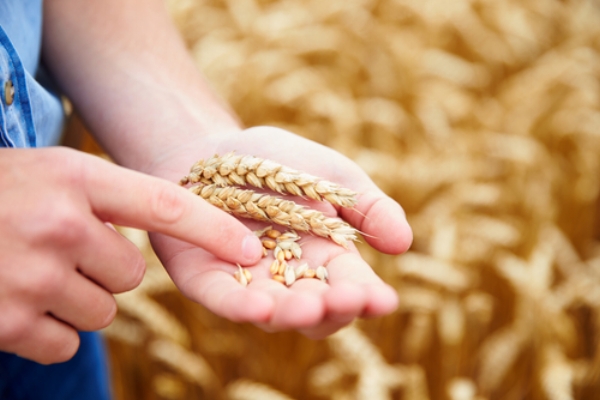Wheat
Kentucky's Wheat Industry
Kentucky ranks 14th nationally in wheat production. Kentucky farmers harvested 29.3 million bushels of winter wheat during the summer of 2024 according to the Kentucky Field Office of USDA'S National Agricultural Statistics Service. This was down 28% from the previous year. Yield is estimated at 75.0 bushels per acre, down 13.0 bushels from 2023. Farmers seeded 560,000 acres last fall, down 50,000 acres from 2023. Area harvested for grain totaled 390,000 acres. Acres for other uses totaled 170,000 acres and was used as cover crop, cut as hay, chopped for silage or abandoned.
Most of the wheat is sold to local flour mills or distilleries.
Top wheat counties in Kentucky:
Christian
Logan
Todd
Simpson
Graves
Source: National Agriculture Statistics Service and Economic Research Commission
Wheat: The scoop on the World’s #1 grain
Wheat was first planted in North America by English colonists. Today, a large portion of wheat is raised in the western United States. Wheat is a very popular grain - in fact, three quarters of US foods that contain grain are made with wheat! We also export grain - half of America’s grain harvest is shipped to other countries. Wheat is grown on more land and is more widely exported than any other grain in the world. It is also the leading source of vegetable protein in human food.
Wheat grows best in cooler temperatures, so Kentucky farmers grow wheat through the fall, winter, and spring. They harvest it in June, weigh it, and sell it to local flour mills. The unit of measurement for wheat is called a bushel, which weighs about 60 pounds. Millers clean and grind the wheat kernels into flour that can be made into grain foods. Each bushel of wheat will make enough flour for 90 one-pound loaves of whole wheat bread. The part of the wheat that is not used for food can be used for livestock bedding and landscaping.
There are six different classes of wheat grown in the united States, and each class is used for a different purpose. Some are better for baking cakes, others are better for breads, while others make fantastic noodles. Kentucky farmers typically grow Soft Red Winter Wheat, which is good for cookies, crackers, pastries, and flatbreads.
The US Dietary guidelines for Americans (DGA) recommend we eat six 1-ounce servings of grains each day to be our healthiest. Of those six servings - at least half (three servings) - should come from whole grains. Whole wheat breads, crackers, and pastas are good choices. White flour wheat foods use flour with added iron, B vitamins and folic acid. Folic Acid enrichment has led to a 32% decrease in some birth defects since 1998.
Photo courtesy of the University of Kentucky.
Kentucky Wheat Production: The Grain Chain
By Katie Pratt, University of Kentucky The mAGazine (Published 2012)
Wheat seed is not very big, but what it helps produce is huge. Kentucky farmers, like the Hunts in Hopkinsville, plant that tiny seed in their fields in mid-to-late October. By June, it has developed into grain that helps fuel economies, create jobs, build corporate partnerships, and most importantly, provide nourishment to countless numbers of people every day in Kentucky and across the nation.
When many people think about Kentucky agriculture, horses and tobacco quickly come to mind, but the state boasts a significant amount of wheat production. Kentucky ranked 16th in the nation in winter wheat production in 2010, with growers producing 16.5 million bushels of the soft red winter wheat that provides flour for cookies, cakes, pastries, breads, and crackers.
Kentucky producers started growing more wheat when double-cropping it with soybeans became popular in the 1970s, giving them the chance to get two crops from a field in one growing season.
Rise in Wheat
Steve Hunt (second from left) and father Wayne Hunt (right) have seen dramatic yield increases in their years as wheat growers, due in part to research conducted by College of Agriculture specialists David Van Sanford (left) and Lloyd Murdock (second from right).
A charter member of the Kentucky Small Grain Growers’ Association, Wayne Hunt has been growing wheat since 1961. His son, Steve, started farming in the 1980s. Steve’s son, Brandon, now has joined them.
The Hunts, like many Kentucky wheat growers, have seen dramatic yield increases.
“In 1962, I got 40 bushels per acre,” said Wayne Hunt. “In 2011, we got 70 to 80 bushels per acre.”
In the 1990s, University of Kentucky College of Agriculture faculty formally organized the Wheat Science Group. They partnered with Kentucky Small Grain Growers, innovative crop producers, suppliers, and consultants, such as Miles Enterprises Inc. in Owensboro. With more intensive management and better inputs, Kentucky wheat yields leapt from a typical 54 bushels per acre in 1997 to some reports of 90 to 100 bushels in 2011.
Over the years, the Hunts have worked with members of the UK Wheat Science Group, including soil scientist Lloyd Murdock and wheat breeder David Van Sanford, on various projects. Trials, such as those for wheat varieties and remote-sensing nitrogen applicators, have helped farmers across the state improve their yields and, more importantly, their bottom lines.
“It’s good to have university specialists who don’t have their heads stuck in the sand,” said Steve Hunt. “The research these guys are doing is cutting edge.”
The Hunts also raise Pembroke wheat, a variety developed by Van Sanford, and use minimal- and no-till practices as much as possible.
“It’s really a good combination of UK wheat scientists and producers,” said Murdock, who is known for his work improving no-till practices. “In Kentucky, we have to be better managers, because we don’t have the field conditions that other states have.”
To the Mill
As wheat production and quality improved in Western Kentucky, Kentucky-based markets began to develop. The Hunts harvest their wheat in June and ship it to Siemer Milling Company in Hopkinsville.
“It’s a direct market for us and other wheat growers in this part of the state,” said Wayne Hunt. “For Siemer to accept the wheat, it has to be government grade, which has actually helped us sharpen our management practices a little.”
Siemer Milling is a flour milling company based out of Teutopolis, Ill. The company built the Hopkinsville facility in 1995. When Siemer arrived, the enthusiasm of Western Kentucky growers and UK specialists was a welcome surprise, said Carl Schwinke, vice president of grain supply for Siemer.
“The growers here have a real desire and intensity to produce a quality product,” Schwinke said. “We were really surprised at how few markets there were here for farmers to sell their wheat year-round.”
Siemer’s Hopkinsville Plant has 36 full-time employees and turns 36,800 bushels of wheat into flour each day.
When the wheat arrives at the facility, it is segregated according to its attributes and blended four or five times to get a consistent product. Then the wheat is cleaned, soaked for four to six hours and cleaned again. This tempers the kernels and makes it easier to separate their parts.
From there, machines roll and sift the grain, producing smaller and smaller particles until the right size is reached for the desired flour.
“Wheat can make one pass through the roller and the sifter, or it can make 20 before it becomes flour,” said Todd Perry, Siemer Milling Hopkinsville Plant manager.
Connecting Companies
Some of that flour blows through a pipe to Siemer’s next-door neighbor, Continental Mills, which produces easy-to-make baking goods.
“Flour is our main ingredient. We were trying to expand the distribution of our products and were looking for a milling partner,” said Mike Churchill, Continental Mills’ Hopkinsville Plant manager, talking about the company’s proximity to Siemer.
The Seattle-based Continental Mills built their connected facility in 1999 and added on in 2008. Flour moves through the pipe at a rate of about 40,000 pounds per hour.
The partnership has been mutually beneficial.
“The Siemer team does a fantastic job of building and keeping good relationships,” Churchill said.
“We use the experience Continental has with their products to make us better,” Perry said. “This truly is homegrown food at its best.”
From the pipe, the wheat flour is stored in silos until Continental puts it to use in their 100-plus formulas for baking mixes.
Feeding the Nation
Continental Mills’ Hopkinsville facility employs 200 people and produces products for several national brands, including Krusteaz, Ghirardelli, and Classic Hearth. Finished products are distributed to club stores and groceries east of the Mississippi River.
In addition to piping flour to Continental Mills, Siemer trucks it 29 miles to Bremner Food Group, the largest supplier of private label crackers, cookies, and snack nuts in the United States. One of the reasons Siemer decided to build the Hopkinsville facility was because Bremner, its largest customer, relocated to nearby Princeton from Louisville in 1993. The Princeton location is Bremner's largest facility. It produces more than 150 million pounds of product each year.
(Note: edited from original) Siemer also provided flour to Ralcorp Frozen Bakery Products (purchased by ConAgra in 2012) in Louisville. Ralcorp Frozen was a national supplier of frozen products, including pancakes, French toast, waffles, biscuit mix, private-brand refrigerated dough, pre-baked cookies, and artisan bread for in-store bakeries. Their major customers included national and regional restaurants, grocery stores, mass merchandisers, and food service distributors, including McDonald’s USA. As the leading global food service retailer with more than 33,000 restaurants in 119 countries, McDonald’s USA serves nearly 68 million people each day and employs 1.7 million.
Kentucky wheat [went] into McDonald’s biscuits, hot cakes, cookies, oatmeal, and McGriddles.
“Farmers and ranchers are a critical part of our supply chain, and as any great chef will tell you, good food starts with great ingredients,” said Danya Proud, McDonald’s USA spokesperson.
With by-products of economic advancements and opportunities, not to mention food products that feed a nation, a grain of Kentucky wheat is anything but small.
Videos
Related News & Articles
A mixed bag of weather events has harvest numbers varying. (10/3)
Kentucky Winter Wheat Production down 28% from 2023 (9/30/2024)
UK researcher unraveling the mystery of a potential global agricultural threat in Kentucky and beyond (December 2023)







